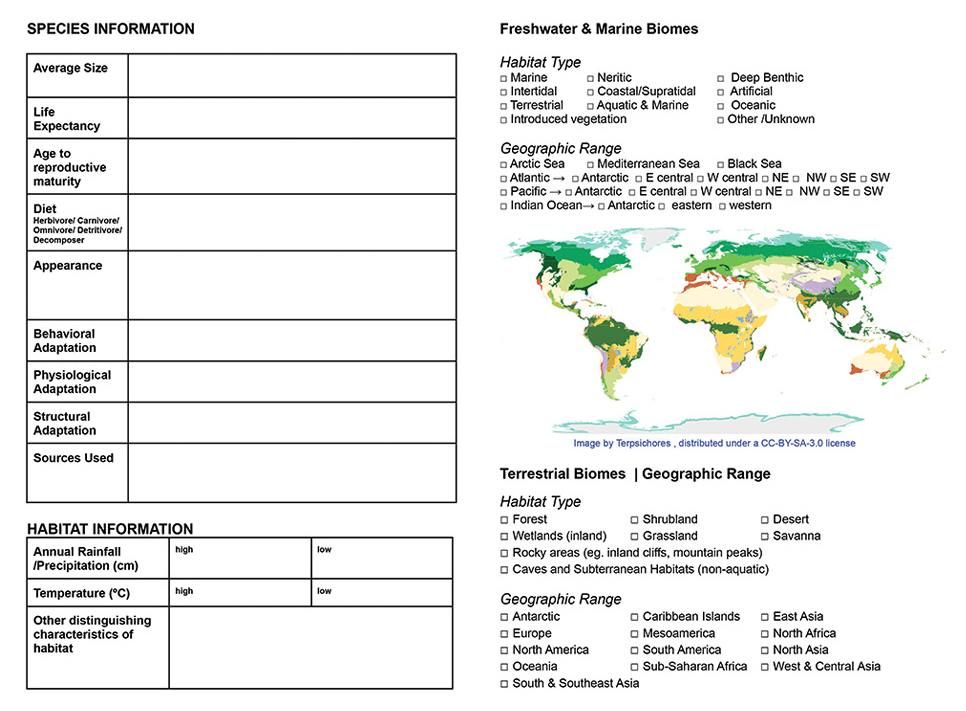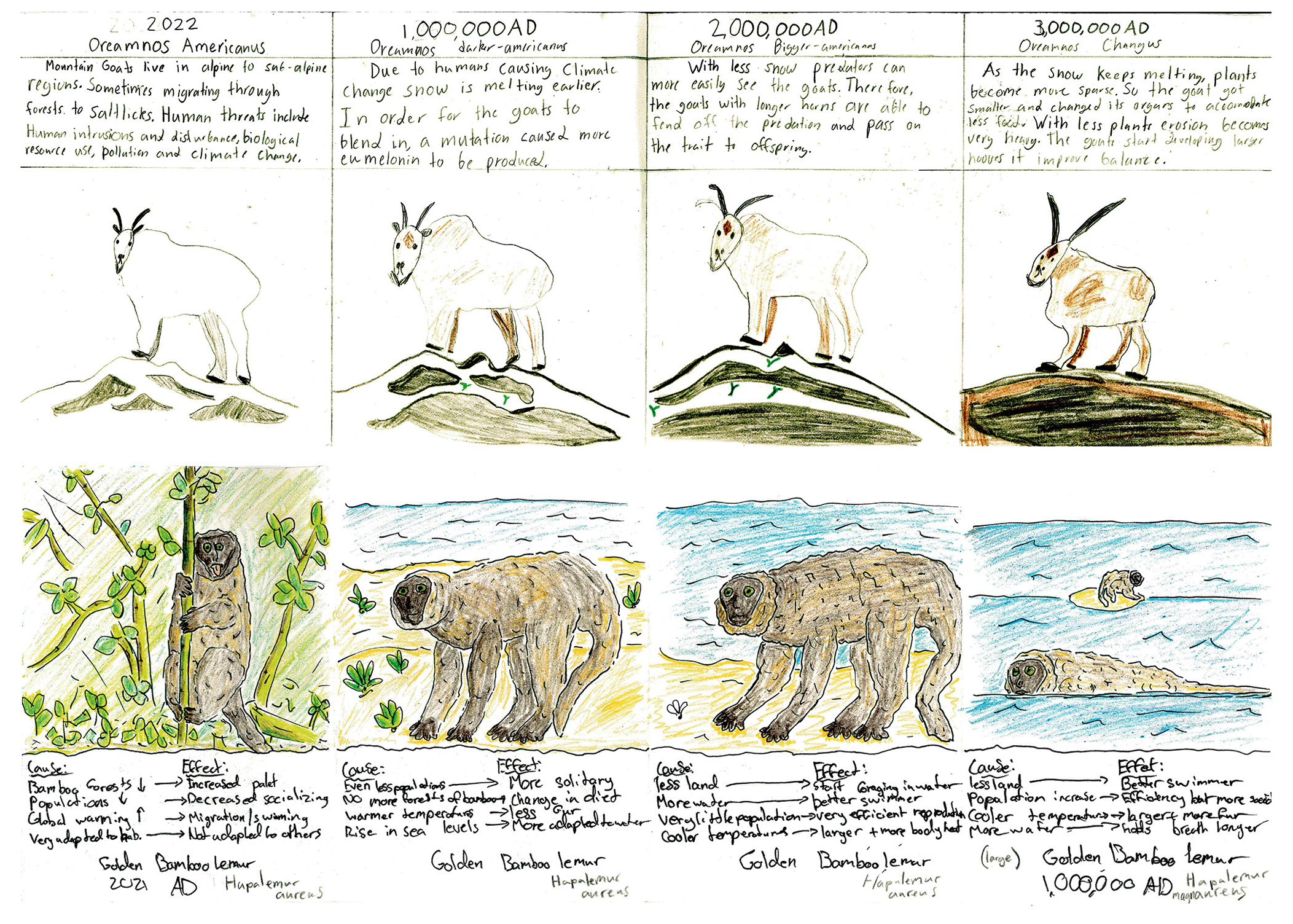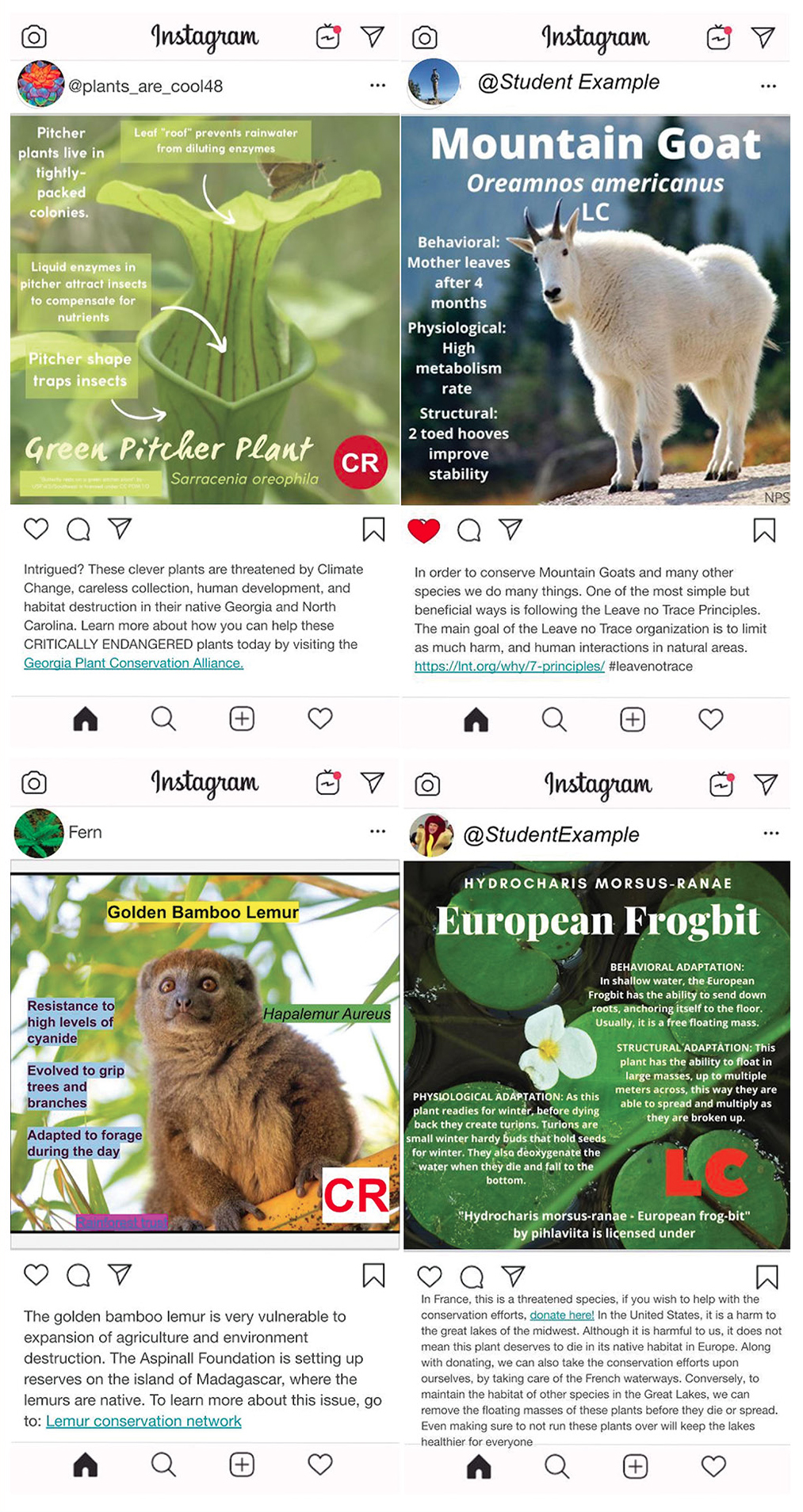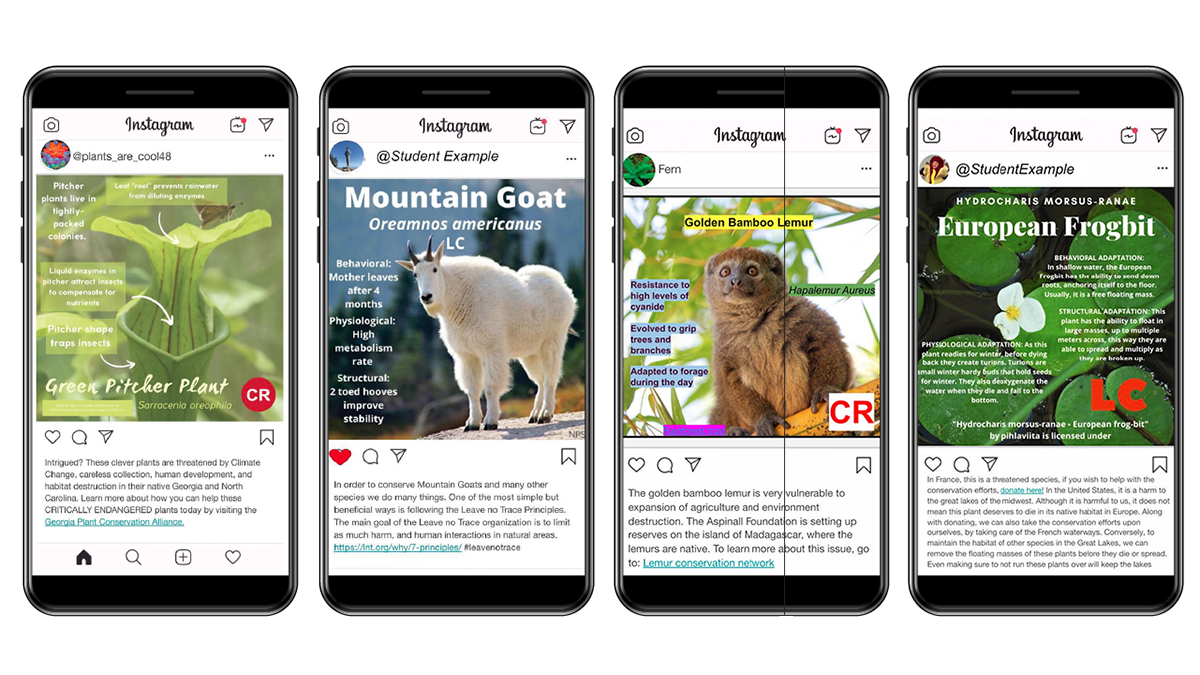feature
What If?
A Creative Summative Assessment to Illustrate the Effects of the Anthropocene on Species Evolution
Are we in the midst of Earth’s sixth mass extinction? Human activity is shifting our climate and environment, affecting the ability of life on Earth to adapt quickly enough to meet these changes. Humans are drivers of ecological change that influence evolutionary pathways impacting the trajectory of all life (Wood et al. 2021). We teach students about Earth’s timeline and the events that shaped life on this planet. Evolution often is thought of as something that happened in the past rather than something currently occurring all around us. Biodiversity is declining, and species have to adapt to the changing world or go extinct as many organisms have before. By changing our teaching practice to contextualize current anthropogenic evolutionary pressures, students will better understand the implications of their actions on the possible progression of life into the future.
What if…? is a four-day summative assessment for a unit on biodiversity and evolution within a general biology course for ninth and tenth graders. Students gather evidence through multiple investigations to answer the questions: “How has life changed on the planet? What has caused those changes? What is happening to biodiversity now and into the future?” Anthropogenic impacts of climate change, habitat loss, invasive species, pollution, exploitation, amongst others, are applying pressure to species and threatening extinction. Students apply the crosscutting concept of cause and effect with an increased focus on their personal choices impacting the environment around them. They will logically anticipate plausible microevolutionary adaptations that are likely to be selected to improve species fitness in the future by one-million-year increments. These microevolutionary events, in turn, support speciation and macroevolution in intervals over one million years (Uyeda et al. 2011).
The assessment is a series of situational questions that explores evolutionary inflection points throughout the history of life on Earth. It was inspired by the concept for the Marvel series “What if...?”, which explores various futures based on alternative timelines. The use of pop culture sci-fi references is the focus of a group of STEM educators called The Science Of, whose aim is to make science relevant and attainable (Brady and Brady 2020). Tapping into student interest creates a starting point to engage creativity. It is a summative assessment for a unit covering evolution and biodiversity. Students analyze anthropomorphic trends, apply mechanisms of evolution, and accurately assign different anatomical, physiological, and behavioral adaptations to increase a species’ fitness 15 million years into the future.
Students gain the understanding that organisms have a limited ability to change behaviors to outpace external pressures, and natural selection will select the fittest phenotype for survival (Harms and Reiss 2019). The underlying mechanism of mutations and epigenetics can improve the chances of evolutionary rescue for organisms having a short life cycle, numerous young, and a short life span; these characteristics allow for the accumulation of mutations to be inherited at an increased rate (McDermott 2019). Students will demonstrate an understanding of evolutionary mechanisms and processes. Evolutionary processes are still happening and influenced by anthropogenic effects that impact the current rate of biodiversity loss worldwide (Wood et al. 2021).
Special attention focuses on the crosscutting concept of cause and effect. Students elaborate on the interplay of biotic and abiotic factors that drive speciation events. Students include drawings of intermediate species to illustrate different adaptations and selection pressures in one-million-year increments into the future in accordance with studies suggesting persistent changes take this long to occur (Uyeda et al. 2011). Drawings are an alternative method of assessing knowledge. Illustrations allow the student to express their understanding of concepts without the use of text, which can be a hindrance to students with learning deficits, English language learners, or students who struggle with verbal skills (Chang et al. 2020).
Day 1. Research
Engage with the task, explore biodiversity, choose a species, discover its natural history, record discoveries
Engage students’ interest by introducing interesting and novel organisms found around the world using virtual reality, websites, videos, and text. Each student will choose one species on which to focus their research project. Encourage the class to select lifeforms from different kingdoms and locations to allow for novel final projects. A preliminary Google search will indicate if there is sufficient information to move forward. Novel and new species are interesting but may not have enough research available to base the remainder of the project. A helpful resource for students to explore is the IUCN Redlist, a comprehensive database of threatened and endangered species all around the globe. Another resource to consider is the EDGE of Existence, which shares global efforts to conserve biodiversity. It highlights projects of scientists and volunteers from all ethnicities and backgrounds exposing students to images representing all types of scientists.
Once students choose a species, they research its taxonomy, natural history, habitat, and human-induced impacts. Students can use Handout A: What If…? Species now and into a possible future to record their findings (Figure 1). It is highly scaffolded to meet the needs of ELL and IEP students but can be reduced to short-answer questions or summarized into a list of research topics. You may edit the scaffolding to match the Lexile level of your students. Students will seek out sources about current trends in the species ranges to predict future trends in the environment and biodiversity due to anthropogenic effects.

Handout A.
What If…? species now and into a possible future is an adaptable graphic organizer. Students research an organism’s natural history and current Anthropogenic challenges using the International Union for Conservation of Nature (IUNC) Red List (2021) and other reliable resources.
Day 2. Analyze
Explore data on anthropogenic pressures on species, analyze the effects on biodiversity, explain the cause and effect on species fitness now and into the future
Each student begins by creating a T-chart that outlines the causes and effects of selective pressures on adaptations that increase fitness. They will use the species they researched the previous day to determine plausible adaptations that improve their species’ fitness. They will draw upon concepts learned throughout the unit as a guide. Students choose the future based on current trends and plausible outcomes from human interactions. Have the students research current and future trends using the IUCN (International Union for Conservation of Nature) Redlist, IPCC (Intergovernmental Panel on Climate Change) report summaries, or the PREDICTS (Projecting Responses of Ecological Diversity In Changing Terrestrial Systems) page from the Natural History Museum of London. Students tend to gravitate to a dystopian future in this exercise. Be proactive by encouraging alternative pathways that include positive human interventions to reduce or reverse climate change, conserve and restore habitat, create circular economies, and other inventive solutions. Just because we have yet to do it does not mean we cannot do it. Hope is an essential part of students’ overcoming apathy and promoting action to improve their futures (Stevenson and Peterson 2015).
Encourage students to work together to evaluate the plausibility of their pressures and adaptations after the initial brainstorming is complete. Consider using a collaborative activity like think-pair-share, a roundtable discussion, or a group concept map to facilitate richer discussion and creative adaptive solutions. Students can also reign in the more imaginative adaptations and keep their peers grounded with logical possible progressions based on the existing natural history of an organism versus evolving their organism in phantasmal ways. For example, loss of water in habitat may lead amphibians to lay egg masses in water and pack in mud (behavioral), the egg glycoprotein composition changes and dehydrates less quickly (physiological) versus the frog sprouting wings and flying to another water source to reproduce.
Day 3. Evolve
Explain causes and mechanisms of evolution, elaborate on adaptations improving fitness in a changing environment
Using Handout B (Figure 2) as a template or a guide, students will explain the cause of the evolutionary pressure, elaborate on the mechanisms at work, and illustrate the changes within the species as a result of the environmental change. Students will create intermediate species at one-million-year intervals. At each interval, students maintain the original genus name and create a new species name of their choice. Encourage students to determine one main selection pressure between speciation events. Many students grasp the complexity of the feedback loops and want to explain every detail of the cause. The cause and effect are easier for their peers to assess if it is simplified with one cause-effect event per time period. For example, increased global temperatures are a catalyst for natural selection to increase fitness for a change in fur or when the new species is active. Students should be slowly adapting their species in response to a new cause every interval to expand their explanation of multiple evolutionary pressures and adaptive responses. (Figure 3).

Handout B.
Students use trends of Anthropogenic effects to show cause-and-effect relationships between the environment and the species regarding evolutionary pressures. Students use sketches and words to illustrate their understanding of evolution by applying these evolutionary pressures to drive speciation events in a hypothetical future over 1 million year increments.

What if…? student examples.
Day 4. Evaluate
Publicly present work, evaluate peers, reflect on learning
A gallery walk allows students to express their ideas in greater detail and their thinking while their peers evaluate the content and reasoning of the project (Figure 4). After the gallery walk, students are asked to reflect. They predict the possibility of their species’ survival into the future based on their knowledge of the mechanisms of evolution, adaptations, and the rate of environmental pressure change (Figure 5). Students are assessed using a standards-based rubric (Figure 6; see Online Connections). An extension activity shows an Instagram post, which highlights the current challenges of their chosen species and ways for others to enact change now to maintain biodiversity (Figure 7).

Peer review for gallery walk.
Student reflection.
Question: Based on the evidence of Anthropocene trends, did you create a plausible set of adaptations selected for (cause/effect)? What adaptations/phenotypes are more likely to make it through the Anthropocene? Why?
Question: This assignment is called What if…? to explore plausible explanations of future adaptations. Do you think what you created is a realistic possible outcome for your species? Why or why not? Based on what you have learned during this unit, do you think your organism will survive the next 500 years? Why or why not?
Question: What can humans do now to mitigate biodiversity loss and help threatened species?

Instagram Extension Student Examples
Conclusion
Upon submission of the unit assessment, students will have demonstrated their understanding of the causes driving species evolution and the selection effects of inherited adaptations. Projects will be analyzed to determine if students met the three learning objectives at an accomplished level. If not, reteaching and revision time will be provided until students meet the requirements set out for the unit. Constant monitoring throughout the process will help ensure common misconceptions about evolution are not perpetuated by the students’ project responses.
Online Connections
Figure 6. Rubric: https://www.nsta.org/sites/default/files/journal-articles/TST90-1/Boisvert/Fig-6.pdf
Climate change 2022: Impacts, adaptation and vulnerability. IPCC Intergovernmental Panel on Climate Change. (n.d.). Retrieved March 1, 2022, from https://www.ipcc.ch/report/ar6/wg2/
Edge of Existence. Retrieved November 18, 2021, from https://www.edgeofexistence.org/
The IUCN Red List of Threatened Species. IUCN Red List of Threatened Species. (n.d.). Retrieved November 18, 2021, from https://www.iucnredlist.org/.
Predicts: Natural history museum. PREDICTS - Projecting Responses of Ecological Diversity In Changing Terrestrial Systems | Natural History Museum. (n.d.). Retrieved March 1, 2022, from https://www.nhm.ac.uk/our-science/our-work/biodiversity/predicts.html
Alicia Boisvert (Ms.Boisvert@yahoo.com) is a biology teacher at Capital High School, Olympia, WA.
Assessment Biology Climate Change Crosscutting Concepts Curriculum English Language Learners Evolution Instructional Materials Life Science NGSS Phenomena High School



